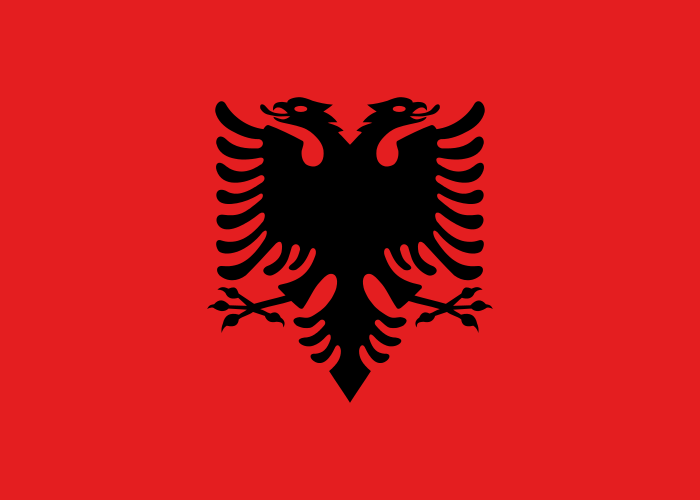The flag of Albania boasts a captivating crimson red background that exudes vibrancy, often described as a mesmerizing "vermilion" or "scarlet" hue. This resplendent color is infused with profound cultural and historical significance, serving as a poignant representation of the valor, fortitude, and countless sacrifices made by successive generations of Albanians in their unyielding pursuit of independence and sovereignty.
A focal point of the flag is the commanding presence of a stylized double-headed eagle, artfully positioned at the heart of the design. This majestic avian emblem, rendered in profile, stretches its wings expansively and directs its dual heads towards opposing edges of the flag. Each head possesses a unique crown, reminiscent of the distinctive mural crowns synonymous with the medieval heraldry of Albania's heritage.
The eagle's plumage is meticulously crafted, intricately capturing the minutiae of individual feathers adorning its wings, body, and tail. This meticulous attention to detail bestows an air of realism and grandeur upon the emblem, evoking a sense of nobility and magnificence that befits its role as a national symbol.
The eagle's formidable talons, prominently on display, underscore its unwavering strength and unwavering readiness to safeguard its realm. Clasping firmly onto a symbolically abstracted representation of a banner, these claws symbolize Albania's unwavering determination to stand resolute and shield its unique identity from any threat.
Enhancing the emblem's dynamism is the slightly ajar beak of the eagle, contributing to an overall sense of animated vigor. Furthermore, the eagle often clutches a diverse array of symbolic objects within its talons. One claw may secure an olive branch, an emblem of peace, while the other firmly grasps a bundle of arrows, signifying the potency that emerges from a united front.
Symbolism:The flag's symbolism reaches deeply into Albania's historical narrative, extending a profound connection to the medieval era and the principality of Arber (Albania). This principality was inaugurated by the valiant Albanian national hero, George Kastrioti Skanderbeg, during the 15th century. In essence, the flag stands as a tribute to Skanderbeg's enduring legacy of resistance against the Ottoman dominion, a testament to his relentless struggle to safeguard and nurture the cherished cultural identity of Albania.
The iconic double-headed eagle, reminiscent of its Byzantine counterparts and other historical emblems, serves as a symbolic embodiment of the fusion between spiritual and temporal authority. Within the Albanian context, the twin heads are emblematic of the harmonious coexistence between the Eastern Orthodox and Western Catholic churches. Moreover, these dual heads eloquently signify the harmonious collaboration between religious and secular leadership, unified for the greater welfare of the nation.
The emblem's inherent duality extends to embrace the kaleidoscope of Albania's regions, cultures, and religious traditions, all converging under the banner of unity. The complementary juxtaposition of the eagle's two heads and shared body magnificently captures the essence of diversity converging into a harmonious whole. The juxtaposition of the olive branch, a universal emblem of peace, and the resolute bundle of arrows further amplifies the nation's aspiration for a blend of tranquility and fortitude, cementing their commitment to strength through unity.
Historical Evolution:Over the course of Albania's storied history, the flag's design has undergone refinements, adapting in response to shifts in governing authorities and regimes. However, the unwavering focal point remains the iconic double-headed eagle, an enduring symbol that reflects the unshakable significance of this emblem within the tapestry of Albanian culture and identity.
In summation, the Albanian flag stands as a testament to the nation's dynamic history, indomitable spirit, and soaring aspirations. Its radiant palette, meticulous intricacies, and layered symbolism converge to craft a poignant and evocative national icon, serving as a wellspring of pride and unity, resonating deeply within the hearts of the Albanian people.
Last Updated on: August 01, 2023